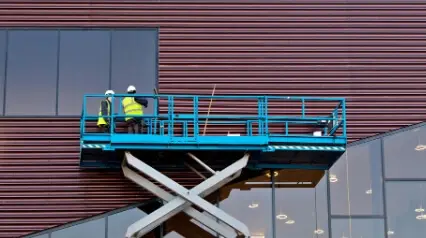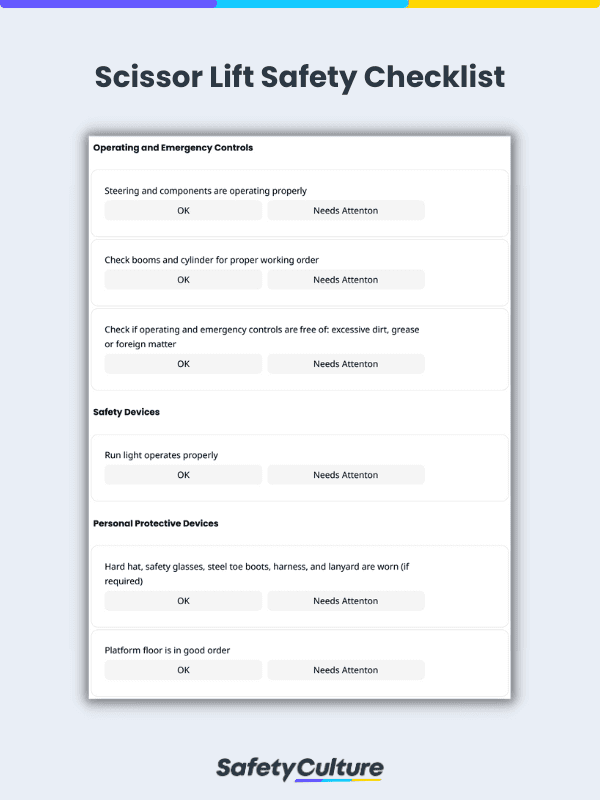What is a Scissor Lift Safety Inspection?
A scissor lift safety inspection is a pre-use and maintenance procedure done to ensure the safety and reliability of scissor lifts.The inspection involves doing a visual assessment of the scissor lift and evaluation of its operating condition. Performing regular scissor lift safety inspections reduces the likelihood of severe injuries and fatalities.
3 Things to Consider During Scissor Lift Inspections
In an OSHA study on the safe use of scissor lifts, it was concluded that most injuries and fatalities involving scissor lifts are due to employers not addressing the following:
- Fall Protection
Workers using scissor lifts are at risk of falls. This can be caused by either machine failure, or lack of equipment and fall protection training for responsible workers operating the lift. According to 29 CFR 1926.451 (g) and 29 CFR 1910.29(a)(3)(vii), OSHA requires scissor lifts to have guardrails installed to prevent injuries and accidents caused by falls. Additionally, all workers involved in using the lift should undergo proper training on proper use and fall protection to prevent accidents or injuries. - Stabilization
Stabilization is essential for safety as unstable scissor lifts are prone to tipping over and collapsing. To avoid this, safe work practices must be maintained. These include the following:- Isolating scissor lift from traffic or other moving worksite equipment to prevent impact
- Ensuring work location is on a firm, level surface away from hazards
- Ensuring weight on the work platform does not exceed the manufacturer’s load rating
- Observing weather conditions meet requirements indicated on equipment label or operator’s manual
- Performing proper maintenance
- Positioning
It is critical for workers and employers to observe proper positioning when using scissor lifts to avoid being crushed or electrocuted. Scissor safety workers should follow the set safety systems such as traffic control measures and ground guides. They should also ensure that they have received the required training for the tasks at hand, including relevant electrical training in accordance with the 29 CFR 1910.269, 29 CFR 1910.333, and 29 CFR 1926 Subpart V. For continued safety and to limit the occurrence of hazards, workers should be watchful of the following:- Operating a scissor lift near a fixed object
- Operating closely with a moving vehicle
- Passing below fixed objects like door frames and support beams
3 Tips to Effectively Implement Scissor Lift Safety
-
- Conduct regular inspections
Regularly performing inspections help ensure overall aerial lift safety and that scissor lifts are in tip-top and safe condition for use. One of the inspections workers should perform regularly is the pre-use or pre-operational inspection. A pre-use check or pre-operational inspection is done to ensure that there is no visible damage to the scissor lift before use. This is done through a walk around inspection format. The areas and items to inspect will depend on the manufacturer’s operation and manual which is why it is important for workers to always refer to it. But most commonly the inspection will involve checking the following:- Required manuals, decals, controlled markings, and placards are present and legible
- Fluid level and the amount of battery charge level
- All components have no missing parts, securely fastened, no visible damage or excessive wear
- Outriggers, switches and locking pins
- Tires and rollers
- Ground controls and switches
- Platform housekeeping
In the event of discovering damage or discrepancy, the scissor lift should be marked and removed from service and reported to proper personnel.
- Regularly maintain scissor lifts
Performing regular maintenance on scissor lifts helps sustain good operational condition of scissor lifts. It reduces the likelihood of mechanical failures, injuries, and operational downtime. To do this, workers should again review the manufacturer’s manual to know the proper maintenance procedures appropriate for the scissor lift. Maintenance will generally include how to:- Test and inspect controls and components
- Ensure that guardrail systems are in good condition
- Verify brakes work and will hold the scissor lift position
- Train workers properly
Employers must ensure that workers are trained on hazards and proper operation of scissor lifts in accordance with OSHA standards (29 CFR 1926.454.) Required trainings will include:- Manufacturer’s instructions for operating scissor lift
- How to handle materials on the scissor lift and being aware of weight limits
- Worksite hazards workers may encounter when working on a scissor lift (e.g., contact with electrical wires) and how to avoid them
- How to report defects or discrepancies
- Conduct regular inspections
SafetyCulture Marketplace: Your One-Stop Work Gear & Equipment Shop
Improve safety in your workplace with SafetyCulture Marketplace as your one-stop shop for all work gear and equipment needs. Get on-demand access to top quality and specialized work gear from trusted equipment brands in the industry—all in one centralized location. Raise the bar of safety and efficiency by empowering employees to request what they need with just a few taps, anytime and anywhere!



